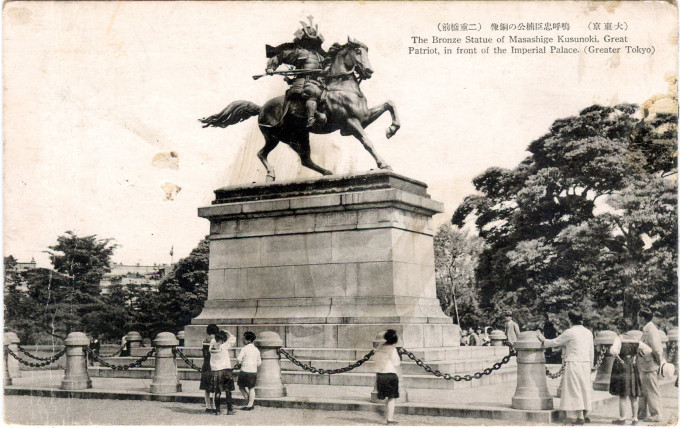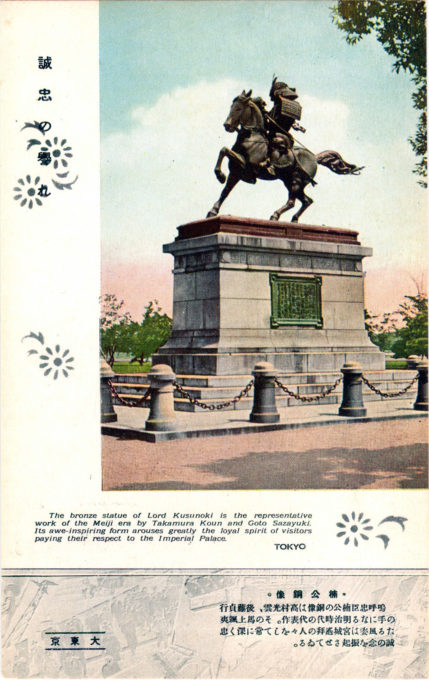“Godaigo Tenno (A.D. 1334) was the Charles I of Japan. His subjects did not indeed cut off his head, but they rose against him under the ambitious leadership of the Ashikaga House, drove him into exile, and set up a rival on the throne.
“Like Charles I, he stood for the divine right of the Emperor; like him, his character seemed to improve with adversity; and like him, his virtues and fortitude won for him many devoted adherents, among them the noble Kusunoki Masashige, whose statue in bronze is one of the most conspicuous ornaments of the Maru no Uchi in front of the Imperial Palace.
“Masashige, defeated by his enemies, preferred suicide to a surrender to rebels against the Imperial House, and his equestrian statue in the Imperial park is a sign to all Japan that the present Government has, under happier auspices, revived the tradition of a divine-right-monarchy, for which Godaigo lost his throne, and Masashige his life.”
–Every-day Japan, Arthur Lloyd, 1909

“The Bronze Statue of Masashige Kusunoki, Great Patriot, in front of the Imperial Palace”, Tokyo, c. 1930.
“Kusunoki Masashige was a 14th-century samurai who fought for Emperor Go-Daigo in his attempt to wrest rulership of Japan away from the Kamakura shogunate and is remembered as the ideal of samurai loyalty.
“A brilliant tactician and strategist, Kusunoki’s cunning defense of two key Loyalist fortresses at Akasaka and Chihaya helped allow Go-Daigo to briefly return to power. However, one of the loyalist generals, Ashikaga Takauji, betrayed Go-Daigo and led an army against Kusunoki and the remaining loyalists. Kusunoki suggested to the Emperor that they take refuge on sacred Mount Hiei and allow Takauji to take Kyoto, only to swoop down from the mountain, and with the help of the monks of Mount Hiei, trap Takauji in the city and destroy him.
“Go-Daigo was unwilling to leave the capital however, and insisted that Kusunoki meet Takauji’s superior forces in the field in a pitched battle. Kusunoki, in what would later be viewed as the ultimate act of samurai loyalty, obediently accepted his Emperor’s foolish command, left his death poem with his young son Masatsura and knowingly marched his army into almost certain death. The battle, which took place at Minatogawa in modern-day Kobe, was a tactical disaster. Kusunoki, his army completely surrounded, down to only 73 of the original 700 horsemen, died from wounds sustained in battle along with his brother Masasue, 11 close clan members, and 60 others. According to legend, his last words were Shichisei Hōkoku! (‘Would that I had seven lives to give for my emperor!’).
“After the full-scale introduction of Neo-Confucianism as a state philosophy by the Tokugawa Shogunate, Kusunoki Masashige, once-called a traitor by the Northern Court, was resurrected along with Emperor Go-Daigo as a precursor of Sinocentric absolutists, based upon the Neo-Confucian theories. During the Edo period, scholars and samurai who were influenced by the Neo-Confucian theories created the legend of Kusunoki and enshrined him as a patriotic hero, called Nankō or Dai-Nankō, who epitomized loyalty, courage, and devotion to the Emperor. In 1880, Kusunoki received the highest decoration from the Meiji government; he later became a patron saint of sorts to the World War II kamikaze, who saw themselves as his spiritual heirs in sacrificing their lives for the Emperor.”
– Wikipedia



Pingback: Imperial Palace panorama, c. 1920. | Old Tokyo
Pingback: Nanko Temple, Kobe | Old Tokyo
Pingback: “Hōjō Sōun (Ise Shinkurō) laying seige to Odawara Castle”, published c. 1930. | Old Tokyo